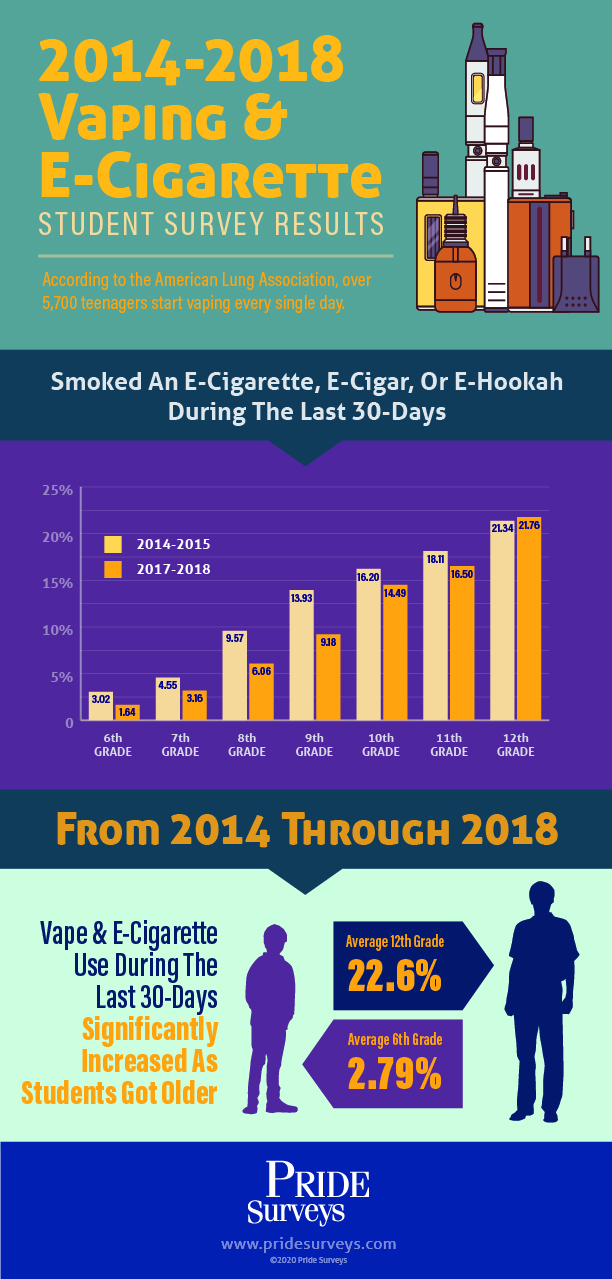Sign up for our information-filled email newsletter

Vaping or E-Cigarette Usage and Resources
Vaping, or e-cigarette usage, continues to be an epidemic amongst teenagers in the United States. According to the American Lung Association, over 5,700 teenagers start vaping every single day. As a whole, however, the issue is still relatively new as compared to other substance abuse concerns. The newness of the vaping devices and the emergence of THC vaporizers means that national surveys have had to adjust their questions to a rapidly changing vocabulary surrounding vaping, resulting in limited amounts of long-term data to track and analyze. Pride Surveys’ mission remains staying on top of e-cigarette usage trends, resources, and health implications as we learn more so we can continue to educate and support our community coalition and school partners. To that end, we have been collecting e-cigarette data since as early as 2013.
E-cigarette Usage Statistics from Pride Surveys Data.
Pride Surveys Data show that when students from sixth through twelfth grade were asked if they smoked an e-cigarette, e-cigar, or e-hookah over the previous 30-day period between 2014 and 2018, the numbers ultimately increased over the five-year period analyzed. In 2014, teenagers reported that 12.1% used over the previous 30-days. While the numbers indicate a decline in 2015, 2016, and 2017, they landed 5.1% higher in 2018 for a total of 17.2% reporting vape pen, e-liquid rig (JUUL, N2, Joytech, etc.), and/or e-cigarette usage, excluding marijuana products in the last 30 days.

Pride Surveys Student E-Cigarette Usage Data Over the Past 30 Days
The other story the data revealed was that the percentage of usage over the previous 30-days significantly increased as students got older, with sixth-graders reporting an average of 2.79% across the five-year period and twelfth graders reporting an average of 22.6%.
Note: In 2017, Pride Surveys switched our question from “During the past 30 days: Did you smoke an e-cigarette, e-cigar, or e-hookah?” to “During the past 30 days: Have you used an e-cigarette, vape pen, e-liquid rig, (JUUL, N2, Joytech, etc.) excluding marijuana products?”.
Vaping Signs and Devices.
Since many types of vaping are odorless, devices and e-cigarette usage can be easy for kids to hide. According to the University of Michigan, a student having a device that looks similar to a USB or has a fruity or minty smell may indicate that vaping is occurring. A teen developing a persistent cough, nausea, pneumonia, chest pain, abdominal pain, or shortness of breath that are not tied to a cold, virus, or asthma may be indicative of vaping usage. Moodiness, lack of motivation, and a decrease in academic or athletic performance may also be factors that come into play. One valuable resource that can help coalitions build programs to help build awareness for parents to determine if their children are participating in drug, alcohol, or e-cigarette usage is PowertotheParent.org. Their Hidden in Plain Sight section features 33 images in a teenager’s room from hidden compartments to décor that may be indicative of substance use.
Potential Health Implications.
The CDC has introduced alarming data about the outbreak of lung injury from e-cigarette and vaping usage. The bad news is that most vaping products contain nicotine, so those who have not smoked traditional cigarettes or pipes previously may now become addicted to nicotine in this manner.
Parent and Community Resources to Help Stop E-cigarette Usage.
Children and teenagers follow what their peers are doing, especially with constant exposure and pressure from social media. As parents and communities help children stop vaping, there are several resources and tips that can help. Smokefree.gov recommends that when you are experiencing any withdrawal symptoms, you consult your primary care physician or other medical professional and increase healthy habits such as exercise, healthy food, support from friends and family, increased water consumption, and good sleep habits. The Vape Talk is an excellent resource for parents who are looking for help starting the conversation with their children.
Given the current times, COVID-19 has a more significant implication on the pulmonary health of children who engage in e-cigarette usage because it is a pneumonia-based pandemic and puts youth at elevated risk for complications. Additionally, other respiratory illnesses may bring comparable concerns.
If you would like to conduct a survey in your community to determine how prevalent e-cigarette usage is, Pride Surveys can help. Contact us today to discuss the challenges in your community or school so we can determine how we can help provide insights in order to combat the problem.
Resources:
https://teen.smokefree.gov/quit-vaping/vaping-addiction-nicotine-withdrawal
https://www.lung.org/quit-smoking/helping-teens-quit
https://www.lung.org/quit-smoking/vape-talk
https://www.cdc.gov/tobacco/basic_information/e-cigarettes/severe-lung-disease.html
http://powertotheparent.org/be-aware/hidden-in-plain-sight/
E-Cigarette Use In Teens
Electronic Cigarettes & Vape Pens: An Overview of the New Trend in Smoking
E-cigarettes, known as e-cigs, electronic cigs, or electronic cigarettes, are the newest generation of traditional cigarettes with a few primary differences: e-cigs are re-usable and trade the characteristic cigarette smoke for a vaporized liquid compound. E-cigarettes (and their sister product “vape pens”) are often seen as the lesser of two evils. However, new research and increased popularity among younger demographics are beginning to prove that e-cigarettes and vape pens may now be a much more insidious problem than their smoky counterparts.
In a scenario that feels like a flashback to a time when cigarettes were a cool kid staple, e-cigarettes have staked their popularity claim with teenagers and young adults. Vaping—the verb invented for e-cig and vape pen use because of the vapor that is released during use—has become hugely popular with the adolescent demographic, a highly problematic trend that is often overlooked by parents, schools, and communities at large.
Teen Smoking Trends: E-Cigarette & Vape Pen Use in Minors
A recent study[1] by the CDC and the FDA’s Center for Tobacco Products (CTP) found that, between 2013 and 2014, e-cigarette use in middle and high school students tripled. While that in and of itself is troubling, another study[2] found that e-cigarettes are frequently a gateway product; teens who have tried e-cigs or vape pens more than twice as likely to start smoking traditional cigarettes than those who haven’t.
The primary reason for this progression is the similarities between the chemical content of e-cigs/vape pens and traditional cigarettes. The main ingredient in e-cigarettes and vape pens (and the reason why users keep coming back for more) is the nicotine content, which is extremely addictive and can have numerous negative health consequences.
While nicotine alone is an inherently harmful drug, the effects on teenagers are magnified exponentially. According to CDC[3] Director Tom Frieden, M.D., M.P.H., “Adolescence is a critical time for brain development. Nicotine exposure at a young age may cause lasting harm to brain development, promote addiction, and lead to sustained tobacco use.”
E-Cigarette & Vape Pen Marketing: Targeting Teenagers
Often billed as a safe alternative to cigarettes, e-cigarette and vape pen manufacturers have faced increased backlash and scrutiny in recent years over claims that they directly target teenagers and adolescents. Marketing for e-cigarettes and vape pens is often found on youth-oriented TV channels and across social media sites, and many e-cig companies use celebrity spokespeople popular with the younger generation. A study by RTI International[4] reported that young adult exposure to electronic cigarette and vape pen advertisements increased by 321 percent from 2011 to 2013. What’s even more important to note though is that this study analyzed only television, and if it were to include internet advertising, the figures would likely be even greater.
Another major way that e-cigarettes and vape pens are being marketed to youth is through the flavoring of the product itself. While some e-cigs come unflavored and unscented, the majority of companies peddle sweet flavor offerings, such as cotton candy, watermelon, and bubble gum, which are seen as particularly attractive to youths. In fact, the FDA has banned[5] tobacco companies from manufacturing flavored regular cigarettes specifically because of their associated appeal to minors.
Governmental Action on E-Cigarette & Vape Pen Use in Young Adults
At this point, most states have laws prohibiting distributors from selling e-cigarettes and vape pens to minors under age 18 (though some states have upped the minimum age to 19). However, while cigarettes and other similar forms of tobacco are currently under strict regulatory control by the FDA, the same oversight does not yet exist for electronic cigarettes and vape pens.
The primary issue affecting restriction and regulation is the relative novelty of the product itself. E-cigarettes and vape pens are fairly new products—the concept of an electronic cigarette was invented[6] in Beijing in 2003. Thus, while in recent years a significant amount of research has been conducted on e-cigarettes and vape pens, they haven’t been as extensively studied and investigated as cigarettes. A quick search for the term “e-cigarette”[7] on PubMed – a collection of biomedical literature by the National Center for Biotechnology Information[8] (NCBI) – returns 1,800 study results. However, over 98% of those results were published in the last 10 years. Particularly crucial to research into e-cigarettes will be longitudinal studies, which would evaluate the long-term effects of e-cigarettes on the human body.
Taking a Stand against Teen E-Cig & Vape Pen Use
Many teens falsely believe that e-cigarettes are safe and non-addictive due to widespread misinformation and deceptive marketing. Therefore, one of the best ways to combat e-cigarette and vape pen use in teens is through education. Parents should talk to their teenagers about the risks and dangers associated with e-cig use. Schools and community organizations should partner to create educational programs and initiatives. Anti-tobacco coalitions need to expand their marketing campaigns to include (or perhaps shift their primary focus to) e-cigarettes and vape pens.
Though the campaign against traditional smoking has been a long process, it has been a hugely successful one as well. Since 1975, when teen smoking hovered just below a staggering 30%, cigarette use has steadily declined[9] to an all-time low under 7.5% in 2014.
This is evidence that it’s possible to reverse the dangerous trend of e-cigarette and vape pen use in teenagers, but only if communities band together to take a stand.
[1] “E-cigarette use Triples among Middle and High School Students in Just One Year.” Centers for Disease Control and Prevention. Retrieved from http://www.cdc.gov/media/releases/2015/p0416-e-cigarette-use.html on March 17, 2016.
[2] “Longitudinal Study of E-Cigarette Use and Onset of Cigarette Smoking among High School Students in Hawai’i.” BMJ Publishing Group, Ltd. Retrieved from http://tobaccocontrol.bmj.com/content/early/2016/01/05/tobaccocontrol-2015-052705.full on March 17, 2016.
[3] “E-cigarette use Triples among Middle and High School Students in Just One Year.” Centers for Disease Control and Prevention. Retrieved from http://www.cdc.gov/media/releases/2015/p0416-e-cigarette-use.html on March 17, 2016.
[4]
Duke, Jennifer C., Youn O. Lee, et al. “Exposure to Electronic Cigarette Television Advertisements among Youth and Young Adults.” RTI International. Retrieved from http://pediatrics.aappublications.org/content/pediatrics/early/2014/05/27/peds.2014-0269.full.pdf on March 17, 2016.
[5]
“What are FDA’s Regulations for Flavored Tobacco?” U.S. Food and Drug Administration.
[6]
“E-Cigarette History.” Consumer Advocates for Smoke-free Alternatives Association. Retrieved from http://casaa.org/E-cigarette_History.html on March 17, 2016.
[7]
“Search Results: E-Cigarette.” National Institutes of Health. Retrieved from http://www.ncbi.nlm.nih.gov/pubmed/?term=e-cigarette on March 17, 2016.
[8]
National Center for Biotechnology Information. Retrieved from http://www.ncbi.nlm.nih.gov/ on March 17, 2016.



